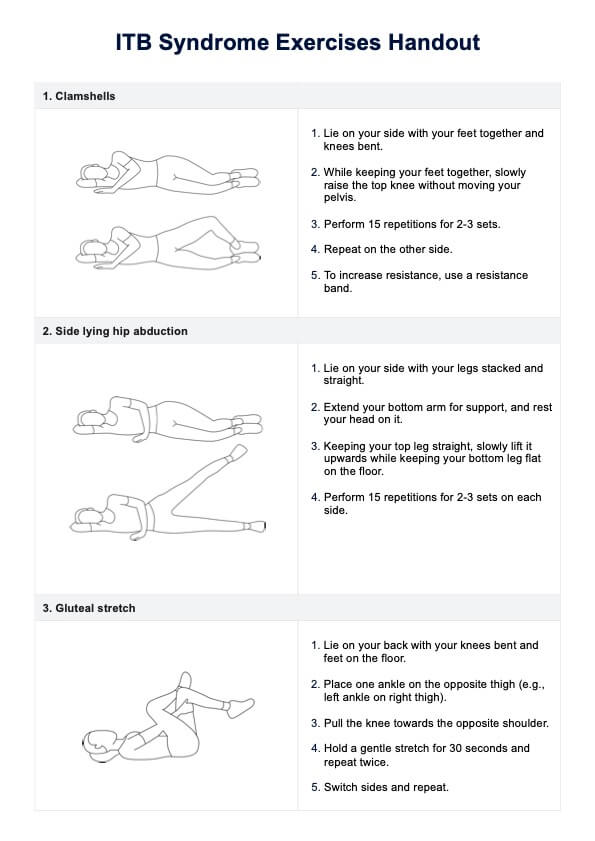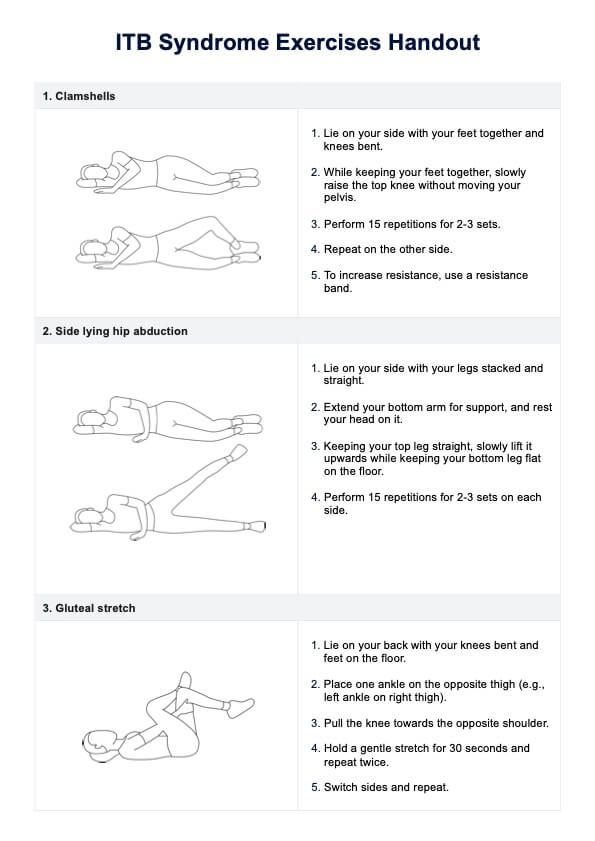ITB Syndrome Exercises Handout
Learn about IT band syndrome exercises with our comprehensive guide for healthcare professionals. Discover the benefits, examples, and effective treatment strategies.


What is iliotibial band syndrome?
The iliotibial band (IT band) is a thick band of fibrous connective tissue that extends from the iliac crest (the top of the pelvis) down the outside of the thigh and attaches to the lateral epicondyle of the femur (the outer part of the knee) and the tibia. By moving forward and backward over the lateral epicondyle of the femur, this band plays a crucial role in stabilizing the knee during activities such as walking, running, and cycling.
Iliotibial Band Syndrome (ITBS) is a common overuse injury that affects the iliotibial band, a thick band of fibrous tissue that runs outside the thigh from the hip to the knee. ITBS is often experienced by athletes, particularly runners and cyclists, due to repetitive knee bending and extending movements. The syndrome occurs when the iliotibial band becomes tight or inflamed, leading to pain and tenderness, typically on the outer knee. Often, this inflammation happens because of friction against the lateral epicondyle of the femur.
Apart from lateral knee pain, symptoms can also include muscle weakness and a clicking or snapping sensation on the knee, especially when the knee is flexed at a 30-degree angle. ITBS can significantly impact an individual's ability to perform physical activities, making early diagnosis and treatment crucial for recovery.
Importance of IT band syndrome exercises
Engaging in targeted exercises for IT band syndrome is essential for several reasons:
Reduces pain and inflammation
Exercises designed for ITBS help to stretch and strengthen the muscles around the iliotibial band, reducing tension and inflammation. By addressing these underlying issues, patients can experience significant pain relief, enabling them to resume their daily activities and athletic pursuits with less discomfort.
Improves flexibility and strength
Regularly performing IT band syndrome exercises can improve hip, thigh, and knee flexibility and strength. Strengthening these areas helps to support the iliotibial band better and distribute the physical load more evenly during movement, reducing the risk of further irritation or injury.
Prevents recurrence
Incorporating IT band exercises into a regular fitness routine can help prevent the recurrence of symptoms. By maintaining flexibility and muscle strength, individuals can avoid the overuse and mechanical issues often leading to ITBS. Consistent exercise can help sustain overall lower body health, minimizing the risk factors and chances of developing ITBS in the future.
ITB Syndrome Exercises Handout Template
ITB Syndrome Exercises Handout Example
6 IT band syndrome exercises
Understanding and teaching IT band syndrome exercises can significantly aid in recovering and managing this condition. Here are six exercises that healthcare professionals can instruct their patients to perform. Each exercise is described in detail, ensuring clarity and effectiveness in practice.
1. Clamshells
Lie on your side with your feet together and knees bent. While keeping your feet together, slowly raise the top knee without moving your pelvis. Perform 15 repetitions for 2-3 sets. After you have done this on the left side, do it again with the right side. To increase resistance, you can also use a resistance band. This exercise targets the gluteus medius and helps stabilize the pelvis.
2. Side lying hip abduction
Lie on your side with your legs stacked and straight. Your bottom arm should be extended for support, and your head should rest on it. Keeping your top leg straight, slowly lift it upwards while keeping your bottom leg flat on the floor. Perform 15 repetitions for 2-3 sets on each side. This exercise strengthens the hip abductors and helps improve stability.
3. Gluteal stretch
Lie on your back with your knees bent and feet on the floor. Place one ankle on the opposite thigh (i.e. left ankle on right thigh, and right ankle on left thigh) and pull the knee towards the opposite shoulder. Hold a gentle stretch for 30 seconds and repeat it twice. If you did it with your left knee, do it with your right knee, too. This stretch is beneficial for relieving tension in the gluteal muscles and improving flexibility in the hip area.
4. Hip flexor stretch
There are two variations of the hip flexor stretch:
- Standing: Stand with one foot flat on a chair and the other leg behind you. Tighten your buttocks to push your hips forward until you feel a stretch in the front of your hip. Hold for 30 seconds and repeat twice.
- Thomas position: Sit at the edge of a bed holding one knee to your chest. Lie back and let the other leg hang off the bed, pressing the heel down to feel a stretch in the front of your hip. Hold for 30 seconds and repeat twice.
5. Single leg stance
Stand with your feet flat in a corner or front of a stable surface like a sink. Place your hands on your hips, keep your legs straight, your hips level, and your trunk upright. Then, balance on one leg straight for 30 seconds. Practice balancing for a total of 2 minutes. This exercise enhances stability and strengthens the supporting muscles around the hip and knee.
6. Standing quad stretch stand
Stand on one leg while holding onto a stable surface, like a wall or chair, for support. Bend the opposite knee, bringing your heel towards your buttocks, and grasp your ankle with your hand. Gently pull your ankle closer to your buttocks until you feel a stretch along the front of your thigh. Hold this position for 30 seconds and then switch to the other leg. Repeat twice for each leg.
7. Standing hip motions
Stand on one leg and perform the following motions:
- Flexion: Move the leg forward.
- Abduction: Move the leg to the side.
- Extension: Move the leg backward.
Start without a resistance band and progress to using a stretchable band. Perform 10 repetitions in each direction for 2 sets. This exercise improves hip mobility and strengthens the hip muscles. Even if you are experiencing ITBS in only your left leg, it helps to do this with your right leg as well to strengthen it (and vice versa).
8. Windmill
Stand on one leg with the knee bent slightly. Bend your trunk forward and extend the opposite leg backward while touching an object on the floor with your hand. Repeat this movement 10 times for 2 sets. The windmill exercise targets balance, coordination, and lower body strength.
How to use our Iliotibial Band Syndrome Exercises Handout
Our Iliotibial Band Syndrome Exercises Handout is designed to assist healthcare professionals in guiding their band pain patients through exercises to alleviate IT band syndrome symptoms and reduce pain. This handout provides a structured exercise therapy approach, ensuring patients receive clear and effective instructions.
Step 1: Review the handout
Start by thoroughly reviewing the handout to familiarize yourself with the exercises and their objectives. Ensure you understand the instructions and can explain them clearly to your patients.
Step 2: Prepare equipment
Ensure that all necessary equipment is available for the exercises. This might include a foam roller, stretch bands, or a chair. These items will streamline the process and ensure patients can perform the exercises correctly.
Step 3: Demonstrate the exercises
Demonstrate each exercise to your patients, emphasizing the importance of proper form and technique. Use the detailed descriptions and images in the handout to guide your demonstration. This will help patients understand how to perform the exercises effectively.
Step 4: Monitor patient progress
As your patients begin the exercises, closely monitor their form and progress. Provide feedback and corrections as needed to ensure they perform the exercises correctly. Encourage them to progress gradually and move on to more advanced exercises when they can perform the initial ones without discomfort.
Step 5: Provide follow-up and adjustments
Schedule regular follow-up sessions to assess your patient's progress and adjust the exercise regimen. Use the handout to track their improvement and modify their treatment plan based on their progress and feedback.
Commonly asked questions
Rest, ice, and anti-inflammatory medications can help reduce pain and inflammation quickly. Incorporating targeted stretching and strengthening exercises can also expedite recovery.
Foam rolling and specific stretches can help reduce band tightness. You can apply pressure with a foam roll along the IT band to alleviate some tension.
The iliotibial band itself cannot stretch significantly, but the muscles around it, such as the gluteal and hip muscles, can be stretched to reduce tension on the band.







































































































